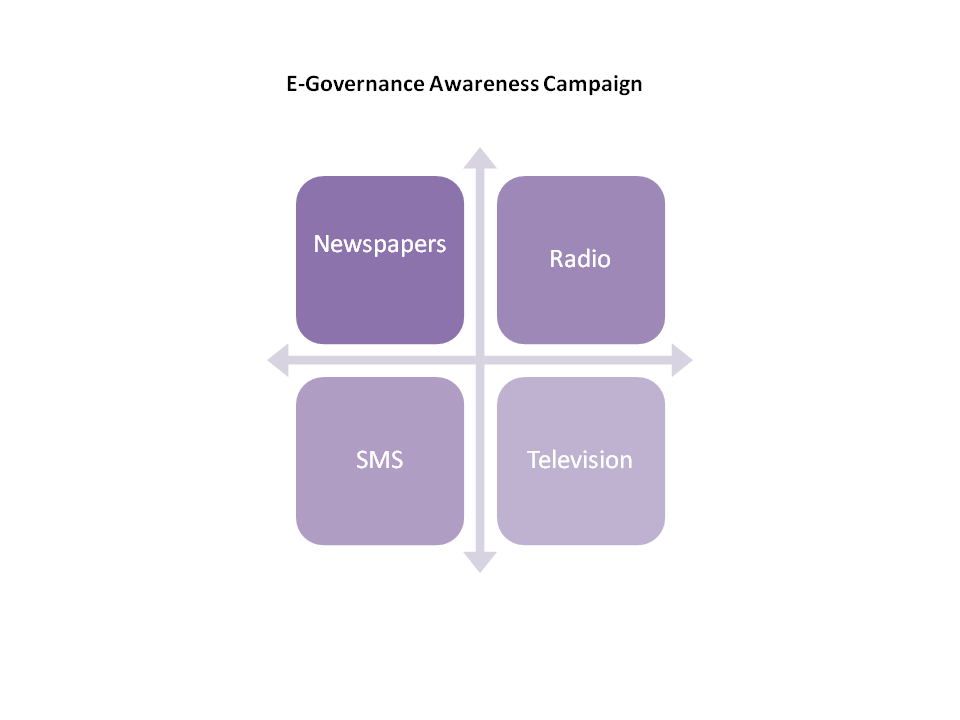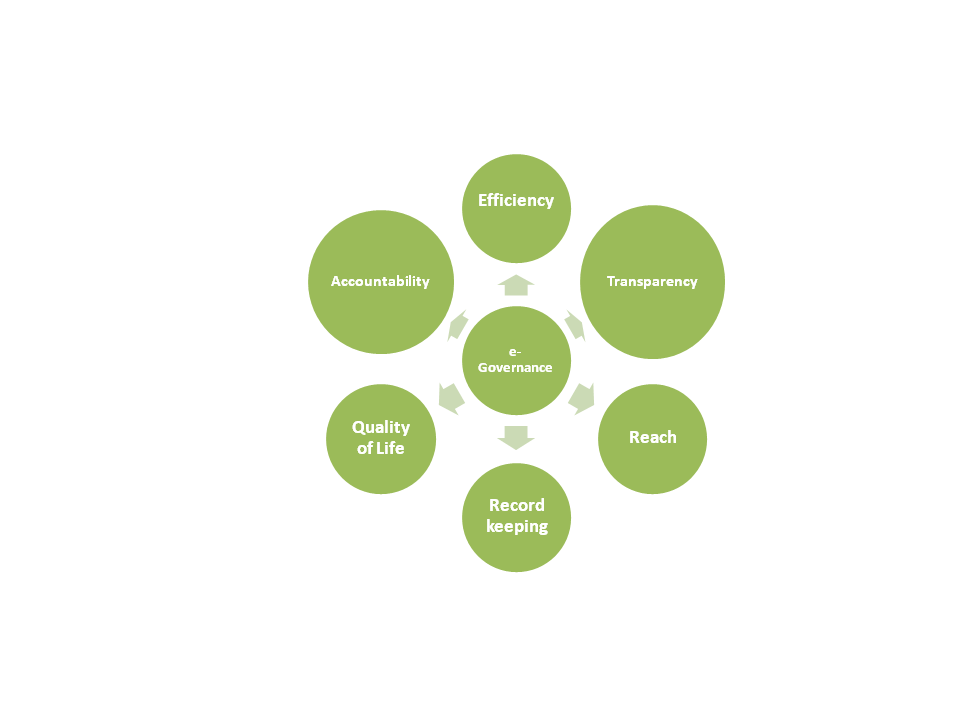Digital India is a path breaking initiative launched by PM Narendra Modi in 2014. The Digital India initiative aims to integrate the government departments and people of India, by making government services available electronically.
Digital India stands on three pillars – digital infrastructure, digital service delivery and digital literacy.
The challenge is to deliver all aspects of this project to every nook and corner of India, to its 1.3 billion people.
e-Governance is the vehicle via which government services will be digitally delivered to the people of India. Hence e-governance is imperative to bring the concept of Digital India to fruition.
What will e-Governance deliver?
e-Governance will aid the common man by allowing a variety of tasks to be done electronically. Reporting births or deaths, checking property records, applying for aid or subsidies is just the tip of the iceberg.
Increase Efficiency
Digital delivery will enhance speed at which reforms or services are delivered.
Increase Transparency and Accountability
e-Governance will reduce bureaucratic red tape and provide users access to processes. By establishing records and audit trails that are available at the click of a mouse, Government employees will be more accountable leading to responsible behavior and reduction in unfair practices and corruption.
Increase Reach
Government services and reforms can be made available to a wider cross section of people, even those in remote areas.
Improved Record Keeping
By digital delivery of reforms and services, the government will have a central data repository providing better statistical reporting and analysis enabling future enhancements.
Citizen Participation
e-Governance can be instrumental in directly collecting feedback from the citizens via secure channels.
Improve Quality of Life
Having access to information at their finger tips, and being able to smoothly access government services and receive entitled aid can let Indians breathe easier. Knowing that you don’t need to make 10 trips to get a job done, or grease someone’s palm can give immense peace of mind to the common man.
Role of Technology in e-Governance
Technology is a key enabler in realizing the vision of Digital India and making e-Governance a reality. Technology will hasten the process of e-Governance and make it available in the remote parts of the country, at a fast pace, and in an affordable manner.
The government has proposed building a massive Fiber Optic Network to reach rural areas. Other instruments like the SWAN or State Wide Area Network, SDC or State Data Center, Service Delivery Gateways and Common Service Centers are part of the proposed infrastructure. But these may still not solve the last mile connectivity problem.
Innovation is critical to keep technology current, and ensure that technology is delivered in an efficient and cost effective manner.
How can we accelerate e-Governance?
e-Governance cannot be successfully implemented until digital infrastructure, digital service delivery and digital literacy are put in place.
Digital Infrastructure
Making the Internet available to the corners of the country – in the jungles of Assam, or Rann of Kutch or the islands of Andaman is no small task.
Considering the massive scope of the project and the short time in which it needs to be delivered, innovation is going to be key.
Innovation will be needed not only in technology, but also in ways the technology is utilized or administered.
The United Nations says that access to the Internet is a basic human right.
The Washington Post says that 4.4 billion people in the world do not have access to the Internet. India accounts for a quarter of those, a whopping 1063 million. That is like 85% of the population, almost.
Providing Internet connectivity to these 85% people is going to be the first necessary step for realizing the vision of Digital India.
Necessity is the mother of invention- Old proverb
Technology pioneers like Google, Facebook and Microsoft have already made inroads into making Internet access available to the rest of the world.
Some of these like Internet.org are already being used in India, and the others can be something that India leverages in the coming years.
Check out some ingenious, cheap, and maybe free ways the Internet may be coming to your phone or computer very soon.
1. Google Loon Project
Google proposes solar powered Internet delivered via balloons. Sounds fantastic? This video shows you how in a very simple way. Pilot programs have already been carried out in New Zealand and California.
2. Facebook Connectivity Lab and Internet.org
In this video, Mark Zuckerberg shows us how he proposes to reduce the cost of the Internet by 100x. The Connectivity Lab is evaluating the use of drones, lasers, satellites and more to make the Internet available to the people.
Internet.org is already launched in India in collaboration with Reliance where a certain number of websites are accessible free of charge to everyone.
3. OneWeb – One Big Satellite network
Greg Wyler of OneWeb aims to launch 648 satellites that will provide Internet access to every person on earth, that too at a low cost. This network of satellites is supposed to be operational by 2018. Aided by Virgin and Qualcomm, this is another formidable option for providing the world with free Internet.
4. The Humble TV and its white space
A project by Microsoft and the Botswana Innovation Hub is delivering telemedicine using the unused frequencies of television. Project Kgolagano allows medical workers in remote areas to transmit high resolution patient images to medical facilities across the globe, allowing them to get accurate diagnoses and better patient care.
5. The Outernet
While corporate giants race to conquer space to deliver free Internet, mini toaster sized satellites will be used to deliver free information. Users will have limited access to certain knowledge based websites and will be able to download documents etc.
The race for delivering a free Internet rivals the space race of the 1960s between the US and the Soviet Union. Hopefully, the free Internet will work toward reducing poverty, creating economic independence, and eradicate dogmas promoting global synergy.
Some or all of these innovative technologies will help reach the last mile and can be used to accelerate the vision of Digital India.
Digital Service Delivery
Just making the Internet available will not be enough. People need to be aware of it, and also be aware of what they can do via the Internet. Broadcasting e-governance initiatives and making people aware of the kind of services and reforms they can access via the Internet is also necessary.
Existing information channels will need to be utilized to educate people about e-governance. The government has successfully done this before, whether it is Polio Awareness or Family Planning. Conventional media like newspapers, radio and television should be extensively used to make people aware of e-governance.
 SMS or mobile text messages are used by most mobile users and it can be an effective and efficient way to push information to people.
SMS or mobile text messages are used by most mobile users and it can be an effective and efficient way to push information to people.
e-Governance should also be made available via people or humans. Digital literacy is fine, but what about people who are illiterate, old or infirm?
Here are some ways in which digital service delivery may be facilitated –
1. Turn local post offices into e-Governance centers
This can be a place where people go to avail digital services. Government staff can aid them in the application process. Although this is not 100% digital, and may give rise to middle men again, it will still lead to a fast and efficient process.
2. Roaming e-Governance Centers
Take the benefits to the people. This will help the farmer in the field who toils from sunrise to sunset and who may be in a time crunch. Or this could help a bed ridden person apply for medical aid.
3. Mobile applications
There is an app for everything. Why not a mobile application for e-governance services? So there can be an app for birth registry and one to apply for a driver’s license. People can install and remove apps when they don’t need them.
A mobile app will reduce the resources used and give the user point to point instructions on what to do in order to avail a service.
4. Language Support
Yes, Hindi is our national language, and English is taught in schools. But we know there are people who understand neither! It may not be enough to just be bilingual. To make e-governance possible for all, the government needs to make these facilities available in multiple languages, at least at state level.
Technology is going to be the biggest enabler in realizing Digital India. But technology as we know it may not be enough. We need to innovate, and think outside the box. We need to do what has never been done before.
5. Hybrid Partnerships or Public Private Partnerships
Grameen Phone in Bangladesh has made phone and Internet services available to underprivileged women in rural areas. A collaboration between a bank and a phone company, it provides a mobile phone to women who open an account. The concept of ‘Village Phone’ allows them to earn some money while making the Internet available to the village people.
Making people aware of what they can do via e-Governance is one aspect. And structuring information such that maximum people can access it are two important aspects of digital service delivery.
Digital Literacy
Digital literacy involves making the people of India computer literate, mobile phone literate and net savvy.
e-Governance can work only when people are literate enough to use the facilities provided to them. A massive digital literacy campaign is necessary and Intel has committed itself to improving digital literacy in India. The Digital Skills for India program, a joint undertaking of Intel and the Indian Government aims to impact 5 million people by the end of 2015.
Intel launched an Android application that provides digital skills training in five languages. The company will work with Bharat Broadband Network Limited to provide digital literacy training to personnel in the first 1000 panchayats to get an optic Fiber network.
Intel, always known as a leader in innovation, is set to aid the Digital India initiative by empowering Indian citizens via digital literacy.
Imparting digital literacy can also be a great volunteer project for individuals and youngsters.
Summing Up
The success of the #DigitalIndia initiative hinges on successful delivery of e-governance, which in turn depends on having the right digital infrastructure and the right systems to make it available to the common man of India. But all these won’t matter if the common man is not literate enough to take advantage of what is available. Hence digital literacy is equally important in realizing the vision of Digital India.
Digital India can empower India and Indians inside out. Empower them from within so that they are equipped with the means to put their best foot forward toward making India a super power.



Very edifying. Thanks for such a well researched, well thought out and well articulated post. It not only gives information on different things happening in the world and how they can be implemented here too, but also forms a big picture of how all these will together help us.
A different dish this time, but delicious too
Hello Pradeep,
Thanks for your visit and the compliment. The topic is so vast and there are so many aspects of it.. I really wanted to simplify and break it down as much as possible.
Also wanted to stress how innovation can accelerate the vision.
Great post, Pragati! You’ve said it all. Good luck! 🙂
Hey Saru! Thanks..read your post on the topic..it’s great!! All for a good cause 🙂
Wonderfully informative post! Have been struggling with no connectivity for the past ten days, so am understandably skeptical about any of this working efficiently 🙁 Ambitious plans will amount to naught until our work culture and ethics improve.
Hey Madhu! I can imagine finding a network must be a challenge for you considering how much you travel, but also a necessity..yes, the road ahead is long for sure!
Thanks for chiming in 🙂